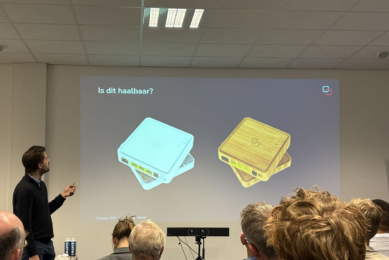There is a lot of buzz right now about Wi-Fi 7 for home users. If you have heard about it, you’re probably wondering how it compares to Wi-Fi 6. We’ll break it down to help you understand the differences and when you should consider upgrading.
Wi-Fi 6 is fast, secure and efficient
Wi-Fi 6, also known by its technical term 802.11ax, is the sixth generation of Wi-Fi standards. Introduced a few years ago, it was widely recognized as a significant improvement over the previous versions. Key features of Wi-Fi 6 include faster speeds, lower latency, enhanced performance for multiple devices, and improved security. It can achieve maximum physical speeds of up to 4.8 Gbps in the 5 GHz and 1.1 Gbps in the 2.4 GHz band. (The maximum data rate is based on 4×4 MIMO mode at 160Mhz and 40MHz bandwidths in the 5 and 2.4 GHz frequency bands, respectively.)
Some user advantages of Wi-Fi 6 include:
Increasing capacity for many devices

Orthogonal Frequency Division Multiple Access (OFDMA) is a technology that enables devices with varying bandwidth requirements. This allows multiple devices and applications to transmit and receive data simultaneously, eliminating the need to wait for their turn. It’s done simultaneously! OFDMA can also work with Multi-User, Multiple Input Multiple Output (MU-MIMO) to further increase upstream and downstream capacity.
Extra security layer
Wi-Fi 6 mandates Wi-Fi Protected Access 3 (WPA3), which is the latest Wi-Fi security protocol. It is built upon state-of-the-art encryption algorithms, which encrypt Wi-Fi frames and protect your home network from hackers and eavesdropping.
TWT improves battery life
Target Wake Time (TWT) is a power-saving feature that schedules when Wi-Fi devices sleep or wake up to send or receive data. This allows your device to reduce energy wake time frequently to inform the Access Point about its presence, which can greatly improve battery life.
Wi-Fi 7 is the next level

Wi-Fi 7 (or the tech name 802.11be) is the latest generation of Wi-Fi standards, promising even faster speeds, improved efficiency, and lower latency than Wi-Fi 6. It builds upon all the great benefits of Wi-Fi 6, including better performance for multiple devices, security, and power savings.
Wi-Fi 7 introduces several new features that elevate performance to the next level.
Multi-Link Operation (MLO) – This innovative feature allows a single device to connect to multiple frequency bands at the same time, rather than toggling between them. The outcome is a more reliable connection, improved stability, and enhanced speed, which you will experience when using various applications at home.
Next level speed – Wi-Fi 7 provides speeds of up to 5.8 Gbps, making it approximately 20% faster than Wi-Fi 6 under the configurations. (4×4 MIMO at 160MHz bandwidth and 0.8µs GI. In Wi-Fi 6, the maximum modulation is 1024-QAM, whereas in Wi-Fi 7, it is 4096-QAM.) This enhancement is ideal for 8K video streaming, allowing users to enjoy ultra-high-definition (UHD) content with incredibly sharp, detailed, and realistic images. It also supports virtual reality gaming and enables ultra-fast downloads.
Improved performance in crowded networks—Wi-Fi 7 utilizes Downlink and Uplink MU-MIMO technology, enabling more devices to receive and send data simultaneously. This results in higher throughput for each device and an overall increase in network performance. This enhancement is ideal for smart homes and home offices where multiple devices are connected at the same time.
Wider channels (up to 320 MHz in 6Ghz) – Wi-Fi 7 doubles the channel width compared to Wi-Fi 6, allowing more data to be transmitted simultaneously. This means you should experience faster download and upload speeds.
Ultra-low latency is a key aspect of Wi-Fi 7, making it ideal for cloud gaming, video conferencing, and real-time applications where every millisecond counts.

Get the right internet speed to use
Wi-Fi 7
Before upgrading to Wi-Fi 7, it’s important to ask: Does your broadband package from your service provider have the speed to take advantage of it? A Wi-Fi 7 router won’t magically increase your internet speed if your package is limited.
Here’s how to determine if you should upgrade:
- Check your broadband package. If your current package offers less than 1 Gbps connectivity in your home, you won’t fully utilize Wi-Fi 7’s benefits
- Pair the right gateway with your speed. If your speed is 2.5 Gbps or higher, a
Wi-Fi 7 gateway will give you the best performance
What gateway do you need for Wi-Fi 7?
To take full advantage of Wi-Fi 7, you’ll need a Wi-Fi 7-compatible gateway that supports 320 MHz channels, MLO, and 4096 Quadrature Amplitude Modulation (QAM), which enables more data to be transmitted per signal. Look for routers labeled as Wi-Fi 7 Ready or 802.11be compliant.
Summing up Wi-Fi 7
If you’re seeking ultra-fast speeds and minimal latency for gaming, streaming, or working from home, Wi-Fi 7 is the ideal choice. This technology provides a future-proof solution to support new devices, ensuring a smoother and faster online experience without buffering or lag while streaming. Wi-Fi 7 connects multiple devices without sacrificing speed, making it perfect for busy households filled with devices, users, and demanding applications.
Are you ready to experience Wi-Fi 7?


